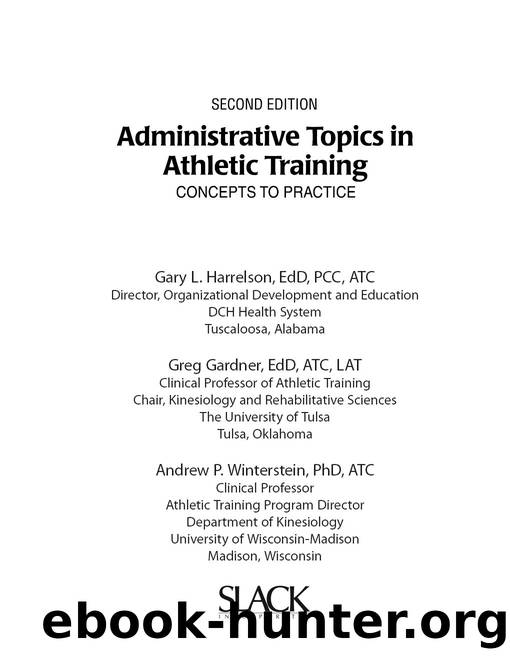Administrative Topics in Athletic Training by Harrelson Gary;Gardner Greg; & Greg Gardner & Andrew P. Winterstein

Author:Harrelson, Gary;Gardner, Greg; & Greg Gardner & Andrew P. Winterstein [L. HARRELSON, GARY]
Language: eng
Format: epub
ISBN: 4647852
Publisher: SLACK, Incorporated
Role StrainâRelationships Among the Components
As identified in the previous citations, a fair amount of research has investigated the various components of role strain experienced by athletic trainers and other health care providers. Additionally, recent socialization research in athletic training has exposed the prevalence of some of these components with evidence to suggest they critically influence an athletic trainerâs roles. Role strain has been linked to a variety of negative organizational outcomes, including job dissatisfaction, depreciated commitment, attrition (or leaving a position), lowered productivity, and even reduced patient care outcomes.35,36 This section will examine other research findings that have examined the relationship among and between these components of role strain.
Role conflict and role ambiguity have perhaps been more widely researched than the other components. Traditional research examined by Klenke-Hamel and Mathieu37 revealed that both role ambiguity and role conflict lead to depreciated job satisfaction and an inclination to leave a position within an organization. More recently, this literature base has been verified and, indeed, role conflict and role ambiguity are directly related to overall job satisfaction, stress, and organizational commitment.38
Johnson et al29 studied the relationship between formalization, role conflict, and role ambiguity. Formalization was conceptualized as the extent to which occupational roles were explicit and supported with such things as job descriptions, rules, regulations, and policy manuals. Their findings showed that formalization was negatively related to both role ambiguity and role conflict; formalization predicted role ambiguity and role conflict. More formalized organizational procedures, such as written policies, clear job descriptions, and explicit procedures, lead to less role conflict and less role ambiguity. Moreover, conducting formal orientation sessions for employees so the policy, procedures, expectations, rules, and regulations are clearly understood is a key to success. The use of formal orientation was suggested by Henning and Weidner,39 who studied role strain among clinical preceptors in athletic training settings. They found that role strain was inevitable but that orientation sessions offered a way to reduce role strain.
Role strain can eventually lead to burnout. In one of the earliest studies on organizational factors related to burnout in athletic trainers, Capel40 examined the relationship of role conflict, role ambiguity, and role overload with dimensions of burnout, including emotional exhaustion, depersonalization, and personal accomplishment. The findings of her study revealed that high levels of role ambiguity and role conflict, as well as the higher numbers of athletes to treat and longer work hours (aspects of role overload), resulted in a higher intensity and frequency of burnout among athletic trainers, although the level of burnout found with athletic trainers was generally low.40
There is no single definition of burnout, although burnout is often related to stress and results in emotional exhaustion, detachment from a job (lack of motivation to perform a role), and low levels of personal accomplishment.
Download
This site does not store any files on its server. We only index and link to content provided by other sites. Please contact the content providers to delete copyright contents if any and email us, we'll remove relevant links or contents immediately.
Human Diseases (MindTap Course List) (by Team-IRA) by Marianne Neighbors Ruth Tannehill-Jones(794)
The Neglected Dimension of Global Security: A Framework to Counter Infectious Disease Crises by National Academy of Medicine Secretariat(405)
Statistical Methods in Health Disparity Research by J. Sunil Rao(388)
Imaging in Urology by Mitchell Tublin MD Joel B Nelson MD(377)
Short Course in Medical Terminology by Nath Judi L.;(321)
Wilkins' Clinical Practice of the Dental Hygienist by Boyd Linda D.;Mallonee Lisa F.; & Lisa F. Mallonee(289)
Clinical Research in Occupational Therapy, Sixth Edition by Martin Rice;(287)
Murray's Basic Medical Microbiology E-Book by Murray Patrick R.;(271)
Anatomical Kinesiology by Gross Michael;(269)
Psychedelics As Psychiatric Medications by Nutt David;Castle David;(260)
Neuroscience Fundamentals for Rehabilitation by Lundy-Ekman Laurie(258)
Public Health and Society: Current Issues by Burke Lillian D.;Weill Barbara;(239)
Health Behavior: Theory, Research, and Practice by Karen Glanz & Barbara K. Rimer & K. Viswanath(239)
The Handbook of Medicinal Chemistry by Simon E Ward;Andrew Davis;(235)
Rang & Dale's Pharmacology 9th Edition plus Flashcards 2nd Edition by Unknown(228)
Cancer Cell Culture by Unknown(226)
Primary Care Occupational Therapy by Unknown(224)
Brown's Evidence-Based Nursing: the Research-Practice Connection by Nowak Emily W.;Colsch Renee; & Renee Colsch(222)
The Politics of Reproduction in Ottoman Society, 1838â1900 by Gülhan Balsoy(220)
